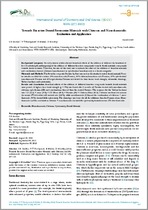Towards bioactive dental restorative materials with chitosan and nanodiamonds: evaluation and application
Date
2015Author
Mulder, Riaan
Grobler, Sias Renier
Moodley, Desi
Perchyonok, Tamara
Metadata
Show full item recordAbstract
BACKGROUND/PURPOSES: Recently various articles showed beneficial effects of the addition of different the beneficial effect (bond strength and longevity) of the addition of different bioactive compounds towards dental materials. compounds towards dental materials. Therefore, the aim of this work was to evaluate the effect of the addition of bioactive materials and combination thereof (chitosan/nanodiamond or cyclodextrin/nanodiamond) to a dental composite. MATERIALS AND METHODS: The flowable composite Premise by Kerr was used as the standard control dental material. Premisewas also modified to contain: 10% nanodiamonds/Premise, 10% chitosan/nanodiamonds/Premise, 10% cyclodextrin/
nanodiamonds/Premise and 10% cyclodextrin/Premise and tested for their dentin bond strength, volumetric shrinkage, Vickers hardness and cytotoxicity. RESULTS AND CONCLUSION: Beneficial effects of the addition of different bioactive compounds towards dental materials were proved. A higher shear bond strength (p < 5%) was found after 3 months of Premise treated with nanodiamonds,
chitosan, cyclodextrin (CD) and combinations thereof than the control Premise. The sequence for the Vickers hardness
was: CD (32.5) < nano (34.8) < CD Nano (38.8) < Premise (39) < Chitosan Nano (42.2). Chitosan was found to increase the mouse 3T3 fibroblast cell survival rate (113%), while nanodiamonds (92%) and the combination of chitosan + nanodiamonds
(93%) showed little cytotoxicity. The shrinkage was lower for all the additions than for Premise alone. Nanodiamonds and the combination chitosan + nanodiamonds showed little cytotoxicity towards mouse 3T3 fibroblast cells.

